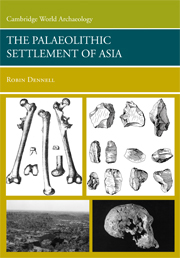Book contents
- Frontmatter
- Contents
- List of Tables, Figures, and Boxes
- Preface
- 1 Asia and Its Place in Palaeoanthropology
- 2 The African Background to the Colonisation of Asia
- 3 The Climatic and Environmental Background to Hominin Settlement in Asia before 1 MA
- 4 The Earliest Inhabitants of Southwest Asia
- 5 The Earliest Inhabitants of South and Southeast Asia and China
- 6 “Out of Africa 1” Reconsidered and the Earliest Colonisation of Asia
- 7 The Climatic and Environmental Background to Hominin Settlement in Asia between ca. 1 Ma and the Last Interglacial
- 8 The Middle Pleistocene Archaeological Record for Southwest and Central Asia
- 9 The Middle Pleistocene Archaeological Record of the Indian Subcontinent
- 10 The Middle Pleistocene Archaeological Record of China and Southeast Asia
- 11 Human Evolution in Asia during the Middle Pleistocene
- 12 Concluding Remarks
- Appendix 1 The Sizes of Countries and Regions in Asia, with Comparative Examples
- Appendix 2 Geographical Coordinates of Principal Early Palaeolithic Sites in Asia
- Appendix 3 Geographical Coordinates of Geological Sections and Cores
- Appendix 4 English Names of Various Mammals Recorded in Asia
- Bibliography
- Index
8 - The Middle Pleistocene Archaeological Record for Southwest and Central Asia
Published online by Cambridge University Press: 05 June 2012
- Frontmatter
- Contents
- List of Tables, Figures, and Boxes
- Preface
- 1 Asia and Its Place in Palaeoanthropology
- 2 The African Background to the Colonisation of Asia
- 3 The Climatic and Environmental Background to Hominin Settlement in Asia before 1 MA
- 4 The Earliest Inhabitants of Southwest Asia
- 5 The Earliest Inhabitants of South and Southeast Asia and China
- 6 “Out of Africa 1” Reconsidered and the Earliest Colonisation of Asia
- 7 The Climatic and Environmental Background to Hominin Settlement in Asia between ca. 1 Ma and the Last Interglacial
- 8 The Middle Pleistocene Archaeological Record for Southwest and Central Asia
- 9 The Middle Pleistocene Archaeological Record of the Indian Subcontinent
- 10 The Middle Pleistocene Archaeological Record of China and Southeast Asia
- 11 Human Evolution in Asia during the Middle Pleistocene
- 12 Concluding Remarks
- Appendix 1 The Sizes of Countries and Regions in Asia, with Comparative Examples
- Appendix 2 Geographical Coordinates of Principal Early Palaeolithic Sites in Asia
- Appendix 3 Geographical Coordinates of Geological Sections and Cores
- Appendix 4 English Names of Various Mammals Recorded in Asia
- Bibliography
- Index
Summary
INTRODUCTION
As noted earlier, Southwest and Central Asia have rain in winter and spring that is derived from westerly winds from the Mediterranean and Black Sea, with hot, dry summers and cool/cold, moist winters (Chapters 3 and 7). Most of this region is today arid or semiarid, and is therefore vulnerable to any reductions in effective rainfall if these winds are blocked or reduced. Much of it is now desert (Table 7.1 and Figure 7.10), particularly inland from the Levantine coast. Almost all the archaeological evidence from the Southwest Asian Middle Pleistocene comes from the Levant (Israel, Lebanon, and western Syria), which has a rich record, with arguably the earliest evidence for symbolic representation, fire, plant processing, hunting, blade assemblages, and lithic assemblages specific to a particular region. There are two reasons that so much more is known about the Levant than inland regions. First, considerably more fieldwork has taken place in Israel than in neighbouring countries; and second, because of its higher rainfall, the Levant would have been a core area of settlement, with more continuous residence during glacial-interglacial cycles. Other “core” areas would probably have been western Turkey, the western Zagros Mountains, and the southern coast of the Caspian Sea.
This chapter has four sections. The first deals with excavated Middle Pleistocene, Lower Palaeolithic sites in the Levant (mostly with Acheulean assemblages).
- Type
- Chapter
- Information
- The Palaeolithic Settlement of Asia , pp. 259 - 335Publisher: Cambridge University PressPrint publication year: 2008



